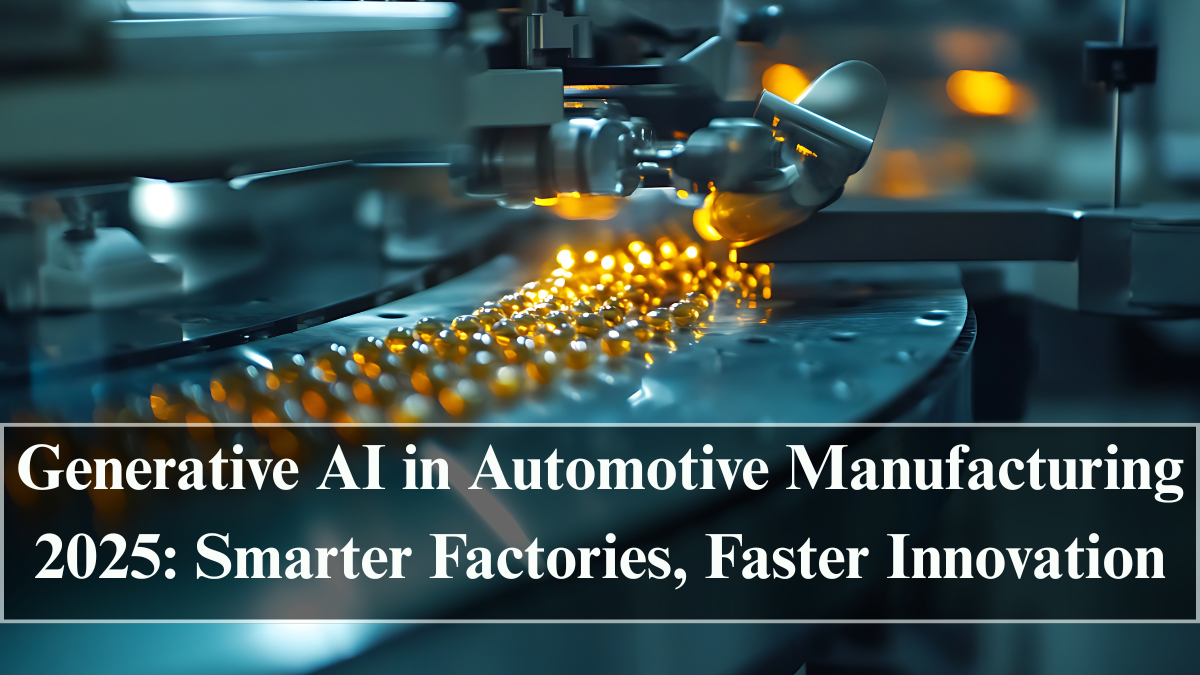In 2025, the global automotive industry stands on the verge of a complete digital overhaul driven by artificial intelligence. Among the most transformative technologies is Generative AI in automotive manufacturing, which is reshaping how cars are designed, tested, and produced. By merging creativity with computation, automakers are using AI-driven systems to reduce costs, enhance efficiency, and speed up innovation cycles. What was once a process that took months can now be simulated and optimized in days.
Generative AI is not just an upgrade to existing manufacturing systems — it represents a new industrial paradigm. Automakers are now using advanced algorithms to generate thousands of potential design solutions, run performance simulations, and automatically identify the most efficient configuration. From lightweight vehicle structures to optimized battery enclosures and aerodynamic surfaces, Generative AI in Automotive Manufacturing 2025 enables manufacturers to create smarter, safer, and more sustainable cars than ever before.

How Generative AI Is Redefining Vehicle Design
The power of generative AI lies in its ability to mimic human creativity while applying mathematical precision. In vehicle design, it starts by setting key parameters such as strength, weight, safety, and material availability. The AI engine then autonomously explores millions of design possibilities to find the ideal balance between cost and performance.
For example, engineers can use generative design to create lighter yet stronger car frames, reducing energy consumption without compromising safety. Companies like BMW and General Motors have already implemented generative AI in prototyping to improve aerodynamics, cabin ergonomics, and even crash resilience. This technology dramatically shortens development cycles while ensuring that every component is tested virtually before production begins.
Smart Factories and Automation Revolution
Generative AI also fuels the rise of smart factories, where automation, robotics, and data analytics converge. These next-generation production environments use AI to coordinate robotic arms, manage supply chains, and optimize assembly line speeds in real time. Predictive algorithms monitor equipment performance to prevent breakdowns, while machine-learning systems schedule maintenance before issues arise.
In 2025, leading automakers are implementing AI-driven quality control systems equipped with computer vision, capable of detecting micro-defects invisible to the human eye. The combination of generative AI and Industry 4.0 principles has created self-learning factories — manufacturing ecosystems that continuously evolve and improve efficiency through feedback loops.
The Role of Digital Twins and Simulation
A major advancement powered by Generative AI in Automotive Manufacturing 2025 is the integration of digital twin technology. Digital twins are virtual replicas of real-world systems that simulate production processes, material flow, and machine performance. By using AI-generated models, automakers can test thousands of configurations virtually before implementing them on the factory floor.
This approach minimizes waste, reduces downtime, and ensures optimal use of resources. Manufacturers can now simulate factory layouts, predict bottlenecks, and refine logistics with unmatched accuracy. In addition, data from connected sensors enables these systems to learn and adapt dynamically, creating a continuous optimization cycle throughout the entire manufacturing process.
Sustainability Through Generative Manufacturing
Environmental responsibility has become a core focus of modern manufacturing. Generative AI helps automakers transition to greener production models by optimizing material selection, reducing energy use, and minimizing waste. It suggests designs that use fewer raw materials, promotes recyclable composites, and simulates energy-efficient workflows.
For instance, an AI algorithm can recommend the ideal structure that uses 20% less material while maintaining full strength. In battery manufacturing, AI tools optimize electrode composition and predict degradation patterns to extend life cycles. These innovations support the global push toward carbon neutrality, positioning Generative AI in Automotive Manufacturing 2025 as a key driver of sustainable mobility.
Collaboration Between Humans and Machines
Contrary to the notion that AI replaces human workers, generative systems enhance collaboration between humans and technology. Engineers now act as supervisors and creative directors, guiding AI systems toward optimal solutions. Human insight remains essential in defining goals, validating outcomes, and ensuring that machines reflect real-world needs.
Leading automakers have introduced AI co-design environments, where teams use natural language or visual inputs to instruct AI models. This human-AI collaboration accelerates innovation, improves product diversity, and empowers workers with tools that amplify their creative potential.
The Future of Generative AI in Automotive
Looking ahead, the convergence of Generative AI, robotics, and quantum computing will redefine every stage of automotive production. Factories will become entirely adaptive systems capable of self-optimization and autonomous error correction. Vehicle design will evolve in real time, with AI suggesting improvements based on data collected from connected cars already on the road.
By 2030, experts predict that up to 40% of new automotive components will be AI-generated. The future of manufacturing is not just automated — it is intelligent, creative, and self-evolving. Generative AI in Automotive Manufacturing 2025 has already proven that the smartest factories of tomorrow are being built today.
FAQs
What is Generative AI in automotive manufacturing?
It’s an AI technology that autonomously generates and optimizes vehicle designs, production systems, and workflows using algorithms and simulations.
How does AI improve vehicle production?
AI enhances production through predictive maintenance, defect detection, and real-time automation, ensuring higher quality and lower costs.
What role do digital twins play in automotive manufacturing?
Digital twins simulate factory operations and product performance virtually, helping manufacturers test and improve systems before real-world implementation.
Is Generative AI helping sustainability?
Yes, it reduces material waste, energy consumption, and emissions by optimizing designs and production processes for efficiency.
What is the future of AI in car factories?
Future factories will use generative AI combined with robotics and quantum computing to operate autonomously, self-learn, and continuously improve production.
Click here to know more.
